The Imagery of Chess Revisited at the Noguchi Museum
by Gordon Fitch
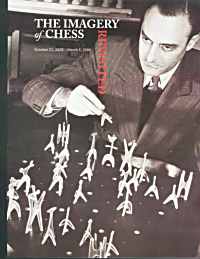
Julian Levy and the Noguchi Chess Set, 1944

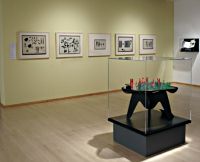
Noguchi Chess Table at the Exhibition


Max Ernst:The King Playing With His Queen (1944)


Man Ray: Wood Chess Set (1920-24)

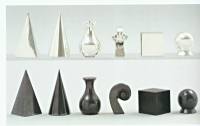
Man Ray: Silver Chess Set

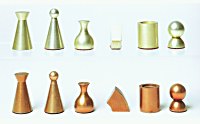
Man Ray: Aluminum Chess Set

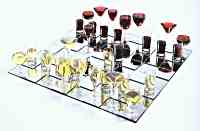
Andre Breton and Nicolas Calas: Wine Glass Chess Set And Board (replica)

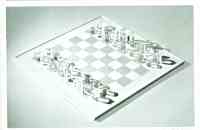
Richard Filipowski: Clear Chess Set (1943)

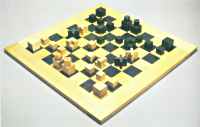
Joesph Hartwig: Bauhaus Chess Set (1924)


Yves Tanguy: Chess Set and Tabletop Board (bef.1939)

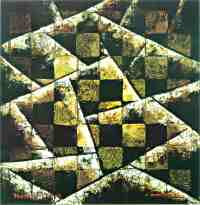
Man Ray: The Knight's Tour, oil on board (1944-46)

According to Bonnie Rychlak, the curator of the Noguchi museum, the show began when the museum acquired a chess table by Isamo Noguchi, the founder of the museum. The chessmen had long since been lost. The effort to re-create the pieces led to the show, for one of the two known pictures of them is of Julian Levy apparently playing a game with them at the 1944 show. "The artist and model maker to whom I turned for help was Larry List," writes Ms. Rychlak. "With the help of computers and a laser cutter, Larry, in consultation with me and other staff at The Noguchi Museum, was able to scale the interlocking forms to their approximate original sizes using only the two photoraphs for reference." But in order to understand the work, List studied the materials and processes available in 1944 America....
In true Surrealist fashion, one improbable thing lead to another, and the second show grew around this thread. Astonishingly, even after sixty years, many of the works in the first show were available for the second, or could be recreated. The two shows are really one show with an intermission of sixty years, with one exception, the addition of some new work which I will write about last.
Chess is a peculiar game which may seem purely rational, even mathematical, to the uninitiate. However, many planes of influence impinge upon it. Unlike checkers, go, and many other similar games, the pieces are personalized; the game is a transcription of war and other forms of politics, and this reference draws in much of human life directly or indirectly. Each of the pieces or characters has a different power, according to its rank, which surrounds with an aura of potency. Many a novel, story and poem has been based on the characters of chess, their situation, and their powers.
For artists and designers, the fact that there are two sets of pieces, and each set must have six ranks, all easily distinguishable, makes for an interesting problem in design, as does the board itself, with its rigid eight by eight system of squares, with which the characters and their auras of power struggle. In this context, Julian Levy, himself an artist as well as a gallery owner, whose efforts had helped to bring Surrealism to America and to legitimate the status of photography as an art, called upon many of leading artists of his day to contribute to the show.
Some of the most famous names of the period responded: Isamo Noguchi, Man Ray, Max Ernst, Marcel Duchamp, Yves Tanguy, Carol Janeway, John Atherton, Eugene Berman, Alexander Calder, Mary Callery, Julio De Diego, David Hare, Heliion, Leon Kelly, Matta, Robert Motherwell, Kay Sage, Kurt Seligmann, Harold Sterner, Murile Streeter, Dorothea Tanning, Ossip Zadkine, Andre Breton, Nicolas Calas, John Cage, Xenia Cage, Richard Filipowski, Steffi Kiesler, Julian Levy, Harold James Ruthven, Vittorio Rieti, and others, some still famous today, other perhaps to be "rediscovered" tomorrow. Media included sculpture, including of course chessboards, both playable and not, painting, drawing, photography, music, writing, and even to some extent haute couture. Besides contributing work, a good many of the artists showed up at the gallery for gatherings related to the show.
The reaction of the artists to the call of chess was highly variegated, yet because of the common theme, the show hangs together in a way that few shows with so many contributors do. In fact, the aesthetic and intellectual "density" of this show, in either incarnation, is astonishing, for one artist's work plays off and reflects others'. Although it does not cover much floor space as museum exhibitions go, one can look at it for hours and go away sure that one has not seen everything.
It isn't possible to give a full description of the show -- that requires a book, to wit, The Imagery of Chess, Revisted, a 210-page book edited by Larry List, which throughly documents the exhibition then and now. The Noguchi Mueseum's web site has also posted a checklist of the show. A list of the works and artists in the original show can be found in the book just mentioned; a few of the works could no longer be located and had to be represented as photographs or in written descriptions. Here, I'll just name a few of the stars:
Marcel Duchamp had already given up painting for chess; he regarded chess as an art, although, having been a painter and sculptor, he couldn't help but design chess pieces, including a flat piece which could be hung on a wall as part of a vertical display of a chess position. He was one of the organizers of the show, and his interest in chess was probably the original spark which began to bring it into being.
Max Ernst, like many others, saw characters of epic and mythic dimensions arising out of the game and sculpted and painted them. One of Ernst's most famous creations, The King Plays With His Queen was inspired by the show, although the most well-known version was constructed later.
Man Ray was not himself present at the show. However, he is well represented by his work. Several of his chess sets are here, as well as some related drawings and other artifacts. He had chosen to spend his exile from France in Los Angeles rather than New York City, and one did not run back and forth from coast to coast in 1944 as readily as today.) He had already been making chess sets in the early 1920s, and saw the design of the pieces as a fascinating and inspiring problem; thus, his work tended away from the mythographies of Ernst and toward a minimalist (and yet surreal) geometricism. In spite of the severity which he applied to the design of the pieces, one should note that the earlier ones employ a found object, the top of a violin, to represent the knight. (Later, the shape of the piece is minimized into a simple arc.)
To some extent, Man Ray's more recent sets were influenced by those of Carol Janeway, also an exhibitor, whose elegant yet down-home ceramic sets were being industrially produced and had become a popular item at upscale department stores. Man Ray saw no reason not to try to emulate her success and did in fact sell quite a few copies of a later aluminum design (although not as many as he would have liked).
Many of the participants, under the influence of Modernism, took the abstraction of the pieces even further, like Richard Filipowski and Joseph Hartwig Perhaps the height of simplicity was the legendary Yves Tanguy chess set, whose original was cut and carved out of a single broomstick and consists entirely of cylindrical forms differing in height and angle of cut.
André Breton, allegedly despising the game, made a joke out of his contribution, although a very elegant joke: the chessmen were represented by different sizes and shapes of wine-glasses, containing either red or white wine. When a piece was taken, the taker was to drink the wine; this might have served to restore advantage to the player who was losing the most pieces. The transparency of the glasses and the wine was enhanced by their being placed on a chessboard consisting of mirrors. This work, as could be expected, had disappeared and was reconstructed for the present exhibition.
Many of the artists who participated chose not to contribute pieces and boards but to use chess as a metaphor in painting and writing, or, like Man Ray, Duchamp, and Calder, contributed both chess boards and other kinds of works, some of which had been made long before the show, and other expressly for it.
Besides Max Ernst's ominous king, the most imposing pieces at the show were Isamo Noguchi's chess set and table, the object which inspired the second (half) of the show, and Xanit Schawintzsky's chess game represented by a table, a chess board, a disembodied hand, and numerous clear plastic rods and wires looping through the air above it to describe the powers and movements of the pieces as a game is played.
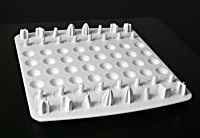
Deborah Tan: Chess Set (2005)

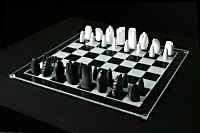
Christine Hagan: Chess Set (2005)

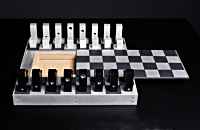
Sergio Silva: Chess Set (2005)

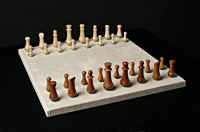
Eddie Chan: Chess Set (2005)


Patricia Tower: Chess Set (2005)

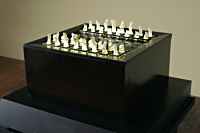
Jean Su Maeng: Chess Set (2005)

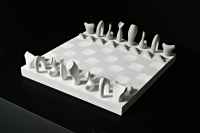
Brian Thomas: Chess Set (2005)

Entries were first submitted on paper, and then of these seven were chosen to be constructed physically. These were (in the order they were set up in the exhibition):
Deborah Tan (Parsons): A "Braille" chess set, for blind players. Each piece has a distinct shape, and the white and black pieces have different surface textures. The squares of the board are indicated by raised markings and Braille inscriptions. The chess set is also visually interesting and pleasing.
Christine Hagen (Pratt): A flowing, minimalist re-realization of the traditional shapes.
Brian Thomas (Pratt): This was the overall winner. The forms of the chessmen were completely reimagined. The squares of the board are incised. The "black" pieces are gray.
Jean Sue Maeng (Parsons): The pieces were made of Spandex stretched over wire. The board itself contains a light source, which shines upward through the board into the pieces, which are translucent. The board is very much like a stage, and theater was one of the metaphors the artist had in mind, according to a note. The entry received an award of Honorable Mention for its originality of conception.
Patricia Tower (Parsons): The pieces are made of plexiglass and plaster in the form of the five Platonic solids from the tetrahedron (pawn) to the icosahedron (queen), and the 60-sided "buckyball" (model of the carbon-60 atom, which resembles some of Buckminster Fuller's structures.) This set, in its geometrical purity,` most resembled the Man Ray boards. This was my favorite.
Eddie Chan (Parsons): This set more or less resembled traditional sets, but with an important difference: each square of the board contain a raised, convex center, and the pieces were rounded on the bottom and weighted so that they would move about and eventually right themselves however they were put down. The artist evidently wanted to give some continuous motion to the game.
Sergio Silva (Pratt): The pieces of this set are severely minimalist, each piece being an extended rectangular prism. The value of the piece is given by its height, and the height and width of a hole in the middle of the piece (except for the pawns, which are simply little blocks).
When I looked at these chessboards I could see that, sixty years later, the show was still alive, and that in these students we have artists and designers whose powers are up to its challenges and opportunities.
Come back in 2120, or hopefully sooner, for the next installment.... Or for more now, get the excellent book, which not only contains an account and pictures from the show, but much interesting information about its circumstances, genesis, and consequences, and about the lives of the people who made it happen.
Text copyright © 2006 Gordon Fitch
Images courtesy of the Noguchi Museum and the Museum of Modern Art
 back to Contents page
back to Contents page